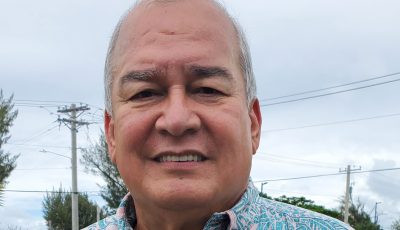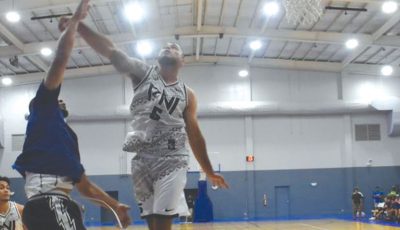FEMA comes to the aid of the NMI during pandemic

Todd Hoose, Federal Emergency Management Agency Incident Management Assistance Team external affairs officer, right, is shown with Col. Elizabeth Tugas, 1984th U.S. Army Medical Hospital senior nurse. Tugas and her six-person team are on Saipan in support of the CNMI’s COVID-19 response. (Brad Ruszala)
The CNMI is stocking up on personal protective equipment and supplies, as well as additional ventilators, in a move to ensure that there will be enough in the CNMI should there be a surge of COVID-19 cases, or a second wave, in the CNMI.
Gov. Ralph DLG Torres said the orders for equipment and supplies were done as early as a month ago, and more shipments are coming in during the week, up until next week. This proactive move was done after seeing the challenges the United States and other countries are facing in terms of not having enough PPEs for first responders and medical professionals.
“I’m confident that our PPEs will be enough for our nurses, our first responders, [and] doctors, but we want more,” he said.
Torres wants to secure enough PPEs for the CNMI, especially with all other countries stopping the export of PPEs “because they know how critical [it is] to protect their people and their country.”
“What we did is we looked on our side of the world and made sure that we’re ahead of the game by ordering our ventilators. We had issues on ventilators alone, [and] understanding how many ventilators are needed in the U.S., even one or two more here in CMMI will help tremendously,” Torres said. Before the COVID-19 pandemic, the Commonwealth Health Center only had 17 ventilators. The current number is still unknown as machines will be arriving in the next few days.
The governor said the CNMI still has more ventilators that “we’re having a hard time bringing in, but it is being worked out, in collaboration with the Federal Emergency Management Agency.
“We purchased PPEs, ventilator supplies, and we also chartered cargo flights through our partners…[who are] working hard and bringing those PPEs, equipment, lab supplies, test kits. We have more coming,” he assured.
According to Torres, while the government paid for the purchases, they are working with FEMA on reimbursements, that they also have already turned in the first project worksheets on the reimbursements.
FEMA external affairs officer Todd Hoose confirmed the arrangement on reimbursements, and added that the cost-sharing ratio is at 75-25%, which means 75% of the cost will be shouldered by FEMA and 25% will be shouldered by the CNMI government. However, Hoose said that that ratio can still change, since the 75-25% split is just the standard ratio.
“Currently, the cost share is 75-25, but that’s going to be up for discussion with the President and with the head of FEMA, because cost share…[is] negotiated based on how impacted a community is, how well they prepared, and what economic means they have,” he said in a separate interview.
Hoose added that FEMA is making sure that all purchases are valid and eligible.
“We want to make sure that PPEs are purchased, it’s valid, certified PPE. Then FEMA reimburses. Everything that’s going on, everything that’s being purchased, everything that’s landing, we’re there, just so we can look at it and say that’s eligible expense,” he added.
According to Hoose, the Commonwealth Healthcare Corp. comes up with a list of necessities, which the Office of the Governor directly procures. “As you know, if it’s purchased directly, it’s so much cheaper. It’s the same quality and so much cheaper than going through the whole federal process. So, whatever they can get directly, they bring it in, show us the bill, and it’s reimbursed at a cost share.”
FEMA also assists the CNMI in getting supplies that the Office of the Governor cannot get directly, through their aircraft.
FEMA flies their aircraft back and forth all over the world to bring in and drop PPEs and supplies to individual states. For the CNMI, the supplies were distributed by FEMA on island, from their aircraft that flew in from Hawaii.
Hoose further said that the supplies actually go from FEMA, straight through the Office of the Governor and right to CHCC, adding that “all these personal protective equipment, it’s all controlled by CHCC…”



























